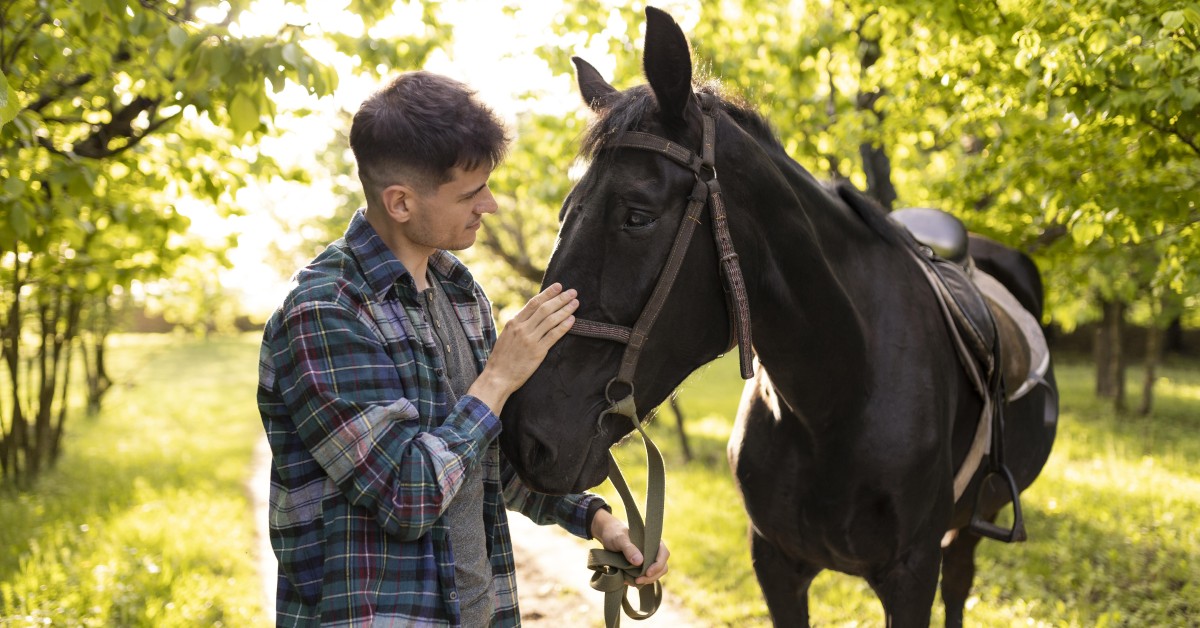Essential Horse Communication Tips
Horses communicate through noises, body language, and other subtle (and not-so-subtle!) cues to express how they are feeling.

As any horse owner knows, these remarkable animals are more than just pets. They are a highly perceptive species capable of forming close relationships with their riders or caretakers. These relationships rely on strong communication and an understanding of complex equine behavior. By learning subtle cues and equine body language, you can advance your horse’s training, avoid dangerous situations, and develop a deeper bond with your pet. Let’s break down horse behavior and how to communicate to ensure that your horse stays healthy and happy.
Horse Body Language: Understanding Silent Cues
Horses rely heavily on body language to express their emotions. Every movement, even subtle ones, can help you interpret how your pet is feeling, whether that means they are happy, frightened, stressed, or in pain. Look for these physical indicators:
- Eyes: Analyze your horse’s eyes to see into their state of mind. Soft, relaxed eyes often accompany a calm and happy horse, while wide eyes with visible whites can indicate anxiety, fear, or sudden alertness. If your horse’s eyes appear darting, it may be nervous or anxious.
- Ears: The movement and position of the ears can also tell you what your horse is thinking. Ears pinned back can be a warning sign of discomfort or irritation. When the ears are brought forward, it may signal curiosity, alertness, or interest. Ears that flicker back and forth are often a sign of attentiveness.
- Legs: Even your pet’s legs can tell you a lot about its emotional state. The pawing of front legs can signify frustration or excitement, while stomping can indicate discomfort or annoyance. Resting a hind leg is often a sign of relaxation, while horses may kick out a hind leg to be playful or as a defense mechanism.
- Tail: The tail is often used as a form of communication, with a raised tail showing excitement and a swishing tail indicating irritation. If your horse’s tail is tucked, it could mean submission or fear, while a loose, relaxed tail is a horse at ease.
- Head: Pay close attention to the position and movement of the head. A lowered head is often a sign of submission or relaxation, while a raised head can mean alertness. If your horse is tossing its head, it could mean it’s in a playful mood or is experiencing frustration.
Vocal Communication: Recognizing Horse Noises
While horses can’t use words like their human counterparts, they do have some vocal ability. Horses use a variety of sounds to express how they’re feeling, including;
- Neighs: A horse will often “neigh” as a way to find their herd mates. It’s a simple way of saying “where are you?”
- Squeals: A high-pitched squeal may be used as a warning, such as when an animal is feeling territorial and is warning others to back off.
- Nickers: The “nicker” sound is a horse’s way of saying “come here.” They may nicker to others in the herd.
- Snores: Audible snores coming from an awake horse often occur during investigation and happen when air is pushed through the nostrils.
- Snorts: Similar to snores, snorts occur when air is pushed from the nostrils, creating a vibration. Some horses tend to snort while working.
- Blows: A horse may release a brief, intense burst of air when it senses danger or is being cautious.
Understanding Horse Behavior Takes Consistency
Like any animal, it takes time to understand horse emotions and behavior. You need to constantly observe your horse and how it reacts to different situations. Seeing how they respond can help you better interpret their behavior and communication methods.
Training is also an important aspect of horse behavior and communication. There may be some behaviors that appear aggressive or unnecessary, such as an overreaction to common stimuli. Training your horse to handle these stressful situations through positive reinforcement can help the animal remain calm and composed in a variety of scenarios.
Being patient and consistent are key when building a bond with your horse. Horses thrive on predictability. Therefore, it’s essential to be consistent in your cues and commands to help your horse learn how to behave and react. Over time, your horse will become more comfortable and confident in their actions.
Next, familiarize yourself with horse social structure. As social animals, horses have a strong herd instinct and will establish a hierarchical structure within their herd, often referred to as the “pecking order.” Understanding this pecking order can give you valuable insight into how your horse thinks and behaves.
Finally, remember that horses have their own fears and emotions. You may not understand why your horse is reacting in a certain way, and while it may not seem logical to you, try to see the situation from the animal’s point of view. Having patience can help build trust between you and your horse, resulting in better overall communication.
Effectively Communicating with Your Horse
Understanding horse behavior requires close observation, patience, and plenty of consistency. By helping the animal adapt to different environments, using positive reinforcement, and getting to know your horse’s body language and vocal sounds, you can create a stronger connection and better respond to your pet’s needs.
Ready to start saving money on pet wellness care?
Then take a look at Mint Wellness, the pet wellness plan that provides fast reimbursement on routine pet care. Save on vaccinations, wellness exams, preventatives, dental, and more!
Learn More